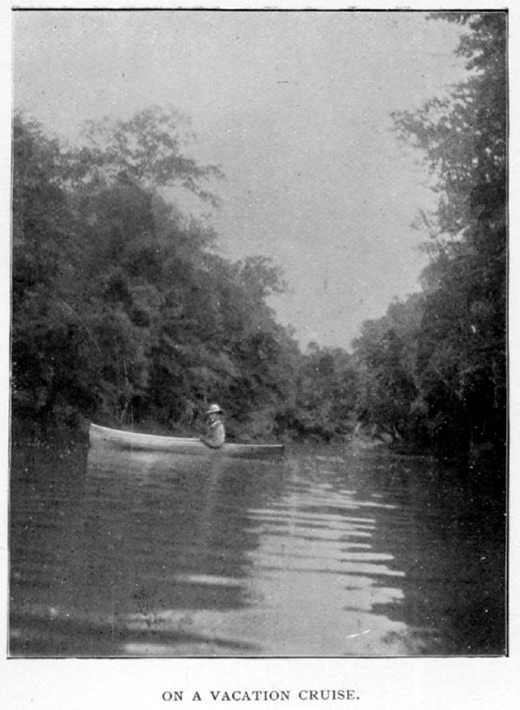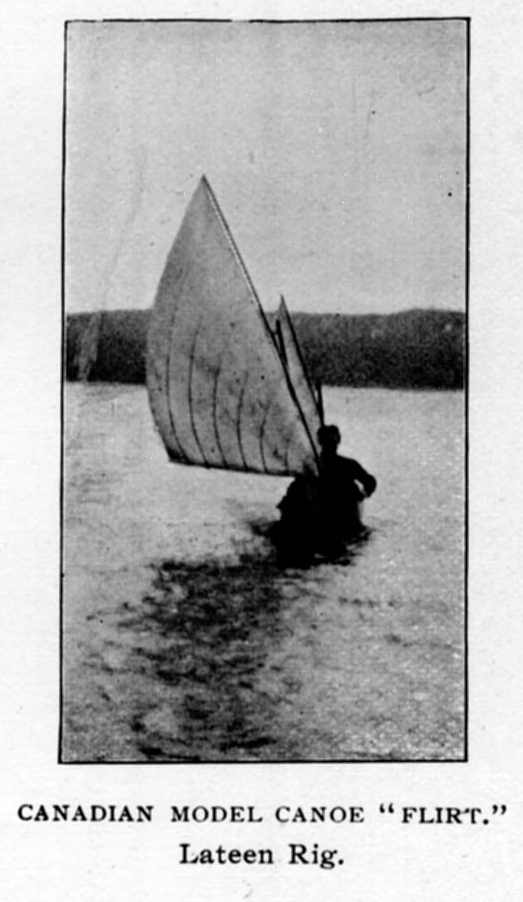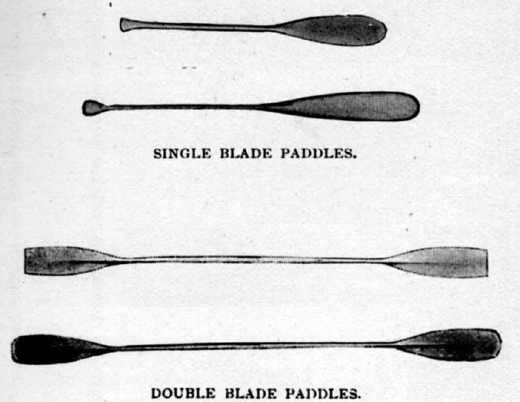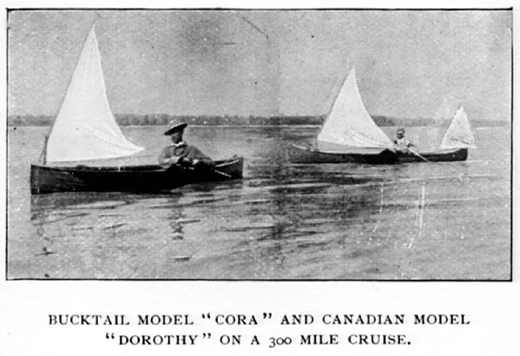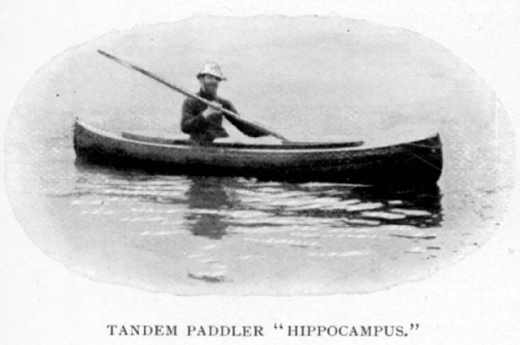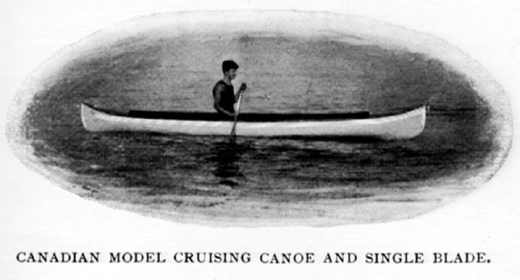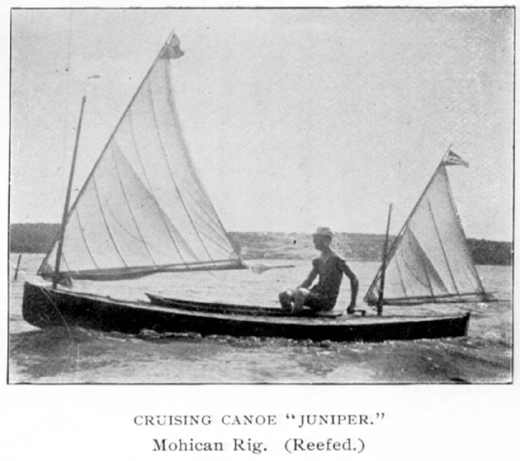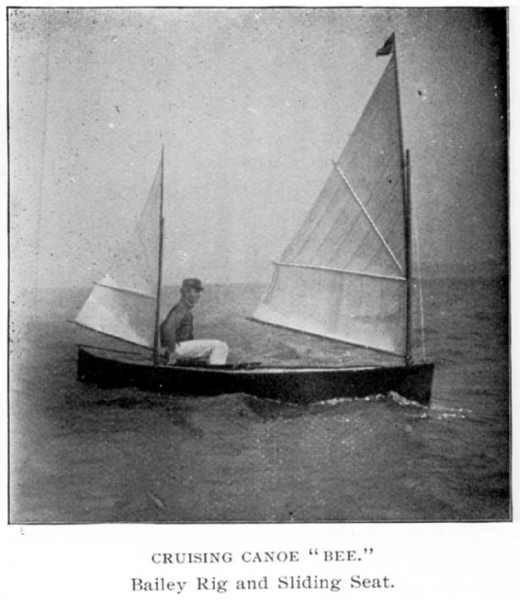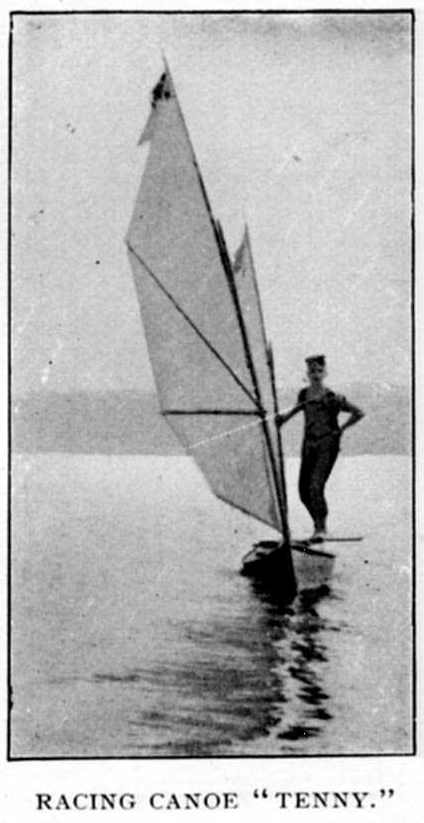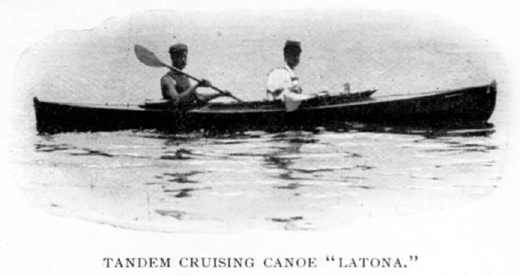CANOE CRUISING AND CAMPING
by Perry D Frazer
CHAPTER I
I N T R O D U C T O R Y.
The author of this book claims nothing for it as an instructor of men to whom canoe cruising and camping, and all that follow in their wake, are as an open book. It is his aim to give to the uninitiated many little hints and suggestions that are usually only learned and mastered after years of experience.
That which first prompted me in this work was as follows: In the cities it is a common thing to hear young men say, "I wish I had some plan of spending my leisure hours in more pleasant manner than by sitting round the house or the parks." If asked why they do not pass holidays and vacations in fishing or hunting, they will say they cannot afford it; that a month in the woods would cost them twice or thrice as much as they can earn when at work a similar length of time; they may not care for horses or bicycles, and a sailboat or small yacht is entirely out of the question, as far as owning one is concerned.
When the reader has thoroughly studied the information I wish to give, I hope he can see how easily he may provide a means of enjoying leisure hours, without great expense.
As in other things in this busy world of ours, there must be an outlay of money. The expenditure in this case can be governed by the length of the purse of the intending canoeist. A really good canoe and outfit can be bought at a moderate cost. When the purchase is made, all that is necessary is to exercise a little care in keeping everything in good order, the expense of which will be very slight.
The benefits that may be derived from canoe cruising are numerous. Aside from the delights of the recreation, from a point of health and physical exercise, nothing can surpass it. The pleasure will never be less than at first, and after years of experience the canoeist will be as much in love with the sport as he was at the end of his first successful cruise.
To brother sportsmen and canoeists -- past masters in paddling, sailing, camping, and cruising -- I will say, if you fail to find anything in these pages that is new, or of benefit to you, do not pass judgment in too harsh manner; be liberal. The book may fall into the hands of the younger men, to whom I hope it will be acceptable, and may teach many of them a method of passing leisure hours far from the too numerous temptations of idle hours in the cities, and teach them a pastime that is the most glorious of all outdoor sports -- the one which remains undefiled by betting and the professional. It has withstood the crucial test of years, and although canoe racing has been and is practiced in every country where the canoe is known, the races have been purely amateur tests of canoes, models and rig , and the prizes are articles of use or ornament to the canoeist. Racing has developed the very best qualities of the various models of canoes, and while a departure from the old time cruising canoe has been made in evolving the modern racing canoe, yet this very thing has been of great benefit to the cruising canoeists in many ways, and while the so called "racing machines" are not practical for cruising, there is a class of canoeists who get as much pleasure from sailing as others do in making long cruises.
CHAPTER II
PLEASURES AND ADVANTAGES OF THE PASTIME.
In many portions of America, and other countries, the game and game fish, once so plentiful, have been swept away by the ruthless bands of selfish persons. The various states in America have, through their legislatures, endeavored to save fish and game from total extermination, and by protection and propagation, have done much good; but in many sections the results have not been satisfactory, or if so, the seasons when game may be killed or fish taken are so short that few can enjoy the privileges of shooting or fishing more than a day or two each year.
To the sportsmen who live in those localities where game and fish are not numerous it is my wish to appeal most strongly : First, because they have a natural love for the fields, the woods, and the water, and their desires in bunting and fishing are not to destroy all the game they can find, but because of the pure delights of being outdoors, close to nature, free from every care and trouble for the time.
As a means of making vacations of a day or a month thoroughly happy ones; as a means of reaching places quickly, economically, and comfortably; and as a means of being nearest to nature and her myriad charms, there can be found no other method so thoroughly independent. and at the same time so agreeable, as canoe cruising. As a method of gaining lost health or strength, or to exercise the muscles, nothing will be found that will equal canoeing. It combines all the good qualities of the results obtained by following advice of physicians, with the pleasing exception that not one of the disagreeable features has to do with it. Canoe cruising can be indulged in at almost any season, while in many of the states one may be out every month of the twelve. There are, of course, seasons when it is not so pleasant to cruise, but from May to November, in the majority of states, there is but little disagreeable weather, excepting the rains, which may come at any time. One can usually be well prepared for rain, however, and need fear nothing of that sort when cruising, especially if in a decked cruising canoe.
We often hear persons ask, "Where can I go for a little vacation without having to pay a small fortune, or more money than I can afford to pay? I do not care to kill a lot of game, or catch many fish, but I want to get outdoors, rest up, have a pleasant vacation, enjoy myself on the water and in the woods, and come home feeling like a new man, and know that my time and money were well invested."
The answer to this question, if followed, will mean more than words can express: Buy a canoe and small outfit, take rifle and rod -- if in the open season for fish and game -- and a camera, and spend your vacation cruising the streams or lakes near your home, or in exploring some river or stream you are not familiar with. If your canoe is properly adapted to your needs, and its rig and outfit of the right sort, you will return from the cruise well satisfied, and
6 CANOE CRUISING AND CAMPING. 7
On a Vacation Cruise
you will be surprised to know that canoe, outfit, and cruise, have cost but little more than a more elaborate outing, from which nothing remained but the memory; then you will have everything needed for future cruises except provisions.
One or two cruises will convince you that the pleasures of the outing were not in killing large numbers of game and fish, and you will come to believe that the greatest pleasure is in being outdoors, in the woods, in camp, on the water. The independence attracts one to cruising, and finally it becomes all absorbing. The canoeist never puzzles his brain for a method of "killing time" on dull days.
You may say there are none but small streams near your home. In that case a small, light, open canoe, weighing less than fifty pounds, and a correspondingly small outfit, will be best. That it was possible to cruise very light was first demonstrated by John MacGregor, a Scotchman, when, early in the '60s, he cruised over the large lakes and rivers of Norway and Sweden in the Rob Roy, with his outfit contained in a rubber bag less than a foot square. MacGregor was the father of modern canoe cruising, and the present cruising canoe, after a quarter of a century of use and improvement, is not widely different from the first Rob Roy.
The advantages of a canoe over a rowboat, or any craft propelled with oars, are numerous. With a canoe one can go any place a rowboat can, and many places the latter cannot. The paddler always faces forward, and in any water he can pick out his course with a nicety, always keeping his eyes on the water head. There is no straining of the head and neck to look behind. All obstacles to a clear course are seen and avoided before nearing them. In rough water, and in narrow, rocky streams or rapids, this is an advantage of great value -- perhaps the greatest of all in favor of the canoe. In hunting, when it is desirable to move through the water without noise, by using a single paddle one may glide along so silently that game will often gaze in astonishment at the strange craft, but bearing no noise, will, for the moment, forget danger in curiosity.
As canoes are made as light as possible of the most buoyant wood, they will support more dead weight in the water than any other craft of similar size. Even when filled with water a small canoe will support a great weight and float. The paddler Sits upright on a comfortable seat or cushion, while a backrest supports the shoulders, and adds strength to the strokes. The kneeling position, adopted by many when paddling with the single blade paddle, is not so comfortable as sitting, but when mastered is far less fatiguing than sitting on the hard thwarts one finds in so many rowboats.
A canoe, when fitted with air tanks, watertight bulkheads, deck, sails and rudder, is really a small yacht. One may live aboard, cook his meals on a tiny alcohol stove without landing, and, if necessary, sleep aboard while afloat. Everything needed for a cruise of a day or a month may be stowed under the deck, and the skipper need depend on no person for a meal or a place to sleep at night.
There is a popular belief among those ignorant of the subject that a canoe is a cranky and dangerous craft to be in on the water. This is an erroneous belief.
8. CANOE CRUISING AND CAMPING. 9
That a canoe is difficult to get into and out of at first is admitted, but when one is seated on the floor or a low seat, the chances of the craft being capsized are very few. A little care at first is needed in getting in and out. Afterward there need be no danger.
The fatal accidents to canoeists have been very few indeed. Compared with rowboats, the percentage is exceedingly low. There is scarcely a river, stream, or lake in the civilized world that has not been explored by canoeists, some of the cruises extending over thousands of miles, and taking several months' time.
CHAPTER III
CANOES.
The word "canoe" covers a large family of craft, and although the meaning of the word is understood, it has never been definitely settled to apply to one particular style of craft. It is easier to say what is not a canoe than what is a canoe.
The American Canoe Association canoe classifications are: "A canoe, to compete in any race of the American Canoe Association, must be sharp at both ends, with no counter stern or transom, and must be capable of being efficiently paddled by one man." The Western Canoe Association rules are identical with the above in this respect, and the rules of the numerous American canoe clubs are similar. The Mersey Canoe Club, of Liverpool, England, classifies canoes as follows "A decked boat not exceeding club dimensions (not over 15 feet long, and a beam of 36 inches), the means of propulsion to be by paddle or sails only, by one person, facing forward."
That rule is very radical, and excludes all open or tandem canoes. The Canadian model canoe is very popular in England, for river use, and it seems strange that any club would make such arbitrary rules. English cruising canoes, however, are more like our canoe yawls than our cruising canoes.
10. CANOE CRUISING AND CAMPING. 11
Flirt
The canoes to which reference will be made in these pages are those which are sharp at both ends, with no counter stern or transom; in length not over 16 feet; beam measure from 26 to 30 inches, depth of about 10 inches, and weighing less than 100 pounds. To apply more accurately to the modern canoe, the length and beam measure might both be given in higher figures, and the material said to be either wood, birchbark, aluminum, paper compositions, canvas, or metal, but for all purposes this is not necessary. Reference will be made in subsequent pages to other than regular models and materials used in construction.
OPEN SINGLES. The open paddling canoe is made by different builders in a large variety of models. The most common is the Canadian model, made of birchbark, wood, or canvas, and taking its model originally from the birchbark canoes of the North American Indians. White and Spanish cedar, and basswood, are most commonly used now, and the planking is either smooth skin or lap streak, fastened to the stem and stern posts, keel, and ribs with small soft copper nails. These are driven from the outside, and the points are turned down and clinched inside. Copper rivets with burrs are sometimes used in the higher grades. Gunwales of hard wood make the craft strong and shapely, and decks of various lengths are put in the bow and stern, to give additional strength and beauty. Crossbraces, or thwarts, are put in by some builders. These add much to the strength of the craft. The number varies according to the size of the canoe. In the very small canoes these are not put in, or if so, only one is used. Light, thin floor boards protect the ribs and planking from injury. In the Canadian models the bow and stern are nearly alike in shape and depth. The latter varies from 16 or 18 inches at bow and stern, to 10 or 11 inches amidships -- this curve of the gunwales from stem to stern forming the "sheer." The keels are often 2 or 3 inches broad amidships, tapering toward the stems, and only extending below the garboards a half inch, sometimes slightly more. The floor, or bottom, is very flat amidships. This gives the canoe its wonderful steadiness in rough water or rapids, when the crew and cargo are low, and some of the weight is below the waterline.
For one person the light open canoes are best, if intended for cruising on small streams where it may often be necessary or desirable to carry over shallow places, rapids, or dams, or in making portages from one stream or lake to another.
One of the best known and universally loved cruising canoeists, "Nessmuk" -- whose books, and letters to the sportsmen's papers, were so charming to lovers of the woods and waters -- cruised over many of the rivers and Streams of America in a white cedar open canoe, the Bucktail, which was about 10-1/2 feet long and weighed 9 pounds 12 ounces. The cruising canoeists and lovers of the woods lost a well-loved friend when Nessmuk died. The Bucktail model and its sister, the Vaux, are still made by J. H. Rushton, the designer. The length is 10-1/2 feet, beam 26 inches, and weight from 20 to 35 pounds.
Such canoes are not mere playthings, but are well and strongly made, and very stanch and dry in moderately
12 CANOE CRUISING AND CAMPING. 13
Paddles
rough water. I have, with a companion, often paddled one of these little canoes, our combined weight aggregating over 300 pounds. I cruised in company with a companion several hundred miles at one time, and on that cruise all sorts of weather and water were encountered, both in sailing and paddling, including nearly a hundred rapids and dams that were both ascended and descended. My companion, in the Bucktail, carried more than one-third of the outfit, and the little canoe behaved fully as well in the rapids and in several fierce squalls as her 16x30 companion canoe.
Awhile very small canoes are excellent for some purposes, larger ones -- 14 to 16 feet long and 28 to 30 inches wide -- will be found safer and better adapted to the uses to which one may wish to put them when cruising. So many canoes from 12 to 16 feet long are made by the builders that one can have a choice of a large number of models and sizes. For cruising on small streams one should secure a canoe with little or no keel, and a very flat floor amidships. It is possible to have a canoe draw less than five inches of water when carrying one man and his outfit, and few should draw more than six inches if intended for small streams.
For single canoes one needs a comfortable seat and a backrest and footbrace. Cane chair backs are often used, or folding seats with cane bottom and back. Double folding cushions of cloth or canvas, filled with hair or cork shavings, are excellent; but are warm and uncomfortable in summer. If the canoe has thwarts, a cane easyback may be placed against one of them, and a cushion of cork shavings used to sit on. In kneeling when paddling, some sort of cushion will be necessary for comfort.
Footbraces of wood are made to suit the length of leg of the paddler by a T-bolt, which permits the brace to be moved in a slot in the floor boards.
Jointed double blade paddles are best. A friction joint of brass permits the two blades to be connected or taken apart at will for stowing or for feathering. One end may be used as a single blade, or for steering when sailing or descending rapid streams.
The length of the paddle is a matter which each canoeist must settle after trial, but for narrow canoes 8 or 8-1/2 feet will be good lengths. Formerly double paddles were about 7 feet long. Now some are 10 feet long, though 9-1/2 is sufficiently long for any canoe. A long paddle should have a narrower blade than a short one, and the round portion should be sufficiently thick to stand the increased strain. Spoon-shaped blades are sometimes used, but for rough work they are not so practical as the straight blades.
The shape of the blade is a matter of choice. For shallow streams square points are more liable to be split or broken than round points. The tapered point is preferred by some for use in shallow water.
Tips of copper or brass give protection to the wood, and are excellent if closely fastened, but if put on loosely they are annoying to the paddler.
Drip cups, to keep the water from running down the round to the paddler's hands, are used a great deal. These can be made of rubber breast-shields, which can be obtained of any druggist. Cut off enough of the nipples to permit the shields to be
14 CANOE CRUISING AND CAMPING. 15
300-Mile Cruise
drawn over the rounds at the joints. They are pushed down the round to within a few inches of the blade, and with the concave portion toward the blade. Care should be taken to keep the rubber away from heat or from being deformed or torn when stowed in the canoe. Small rubber or leather rings are also used for this purpose, and I have found that leather cups, similar to the rubber ones, last much longer.
The simplest device for this purpose is the common round soft rubber ring used on umbrellas to hold the ends of the ribs close to the handle when the umbrella is closed. Two of these on each blade will prevent any water from dripping into the canoe, except with paddles less than 8-1/2 feet long, in which case the blade must be dipped so near the canoe that the recovering blade is held very high in the air. The water will, in that case, run down the round. Place two of the rubbers over each round and push one down near the blade, leaving the other four to six inches further up the round. Any drops of water which run over the first ring will be stopped by the second.
Regular drip cups can be had of the trade for 25 cents each pair. These are of soft rubber, well made, and very serviceable. Care should be taken, however, not to lay the paddles down under any heavy object, which will deform the cups.
Cringle blade paddles are used in single canoes extensively in some parts of the world, but the novice had best learn to become well acquainted with his canoe and double blade before depending on the single for anything but practice. On lakes and sluggish streams the single blade is at its best, and when, in hunting or fishing, the canoeist wishes to move as silently as possible.
The best single blades are made of white spruce or soft maple, and are usually from 4-1/2 to 5-1/2 feet in length. A neatly rounded knob, to fit the palm of the hand, is found at the upper end. The blade is from 18 to 24 inches in length and made in a variety of shapes and widths. The width should be in proportion to the paddler's strength. Wide blades are not easy to use at first, and are tiring, requiring, as they do, much more strength to operate. As with double blades, round points last longest. This applies still more to the single, as it is dipped deeper and more often used in pushing against rocks or gravel.
The single blade paddle should be quite stiff, with very little spring to the round or handle. Some prefer a springy blade, and in a wide blade this is not so objectionable for a bow paddle. These are often termed "lazy man's paddle," or "woman's paddle." The edges of the blade should be quite thin, to present as small a surface to the water as possible and to prevent noise by rippling the water when the paddle is recovered after a stroke.
Even the very small open canoes are sometimes fitted with air tanks made of soft copper. These are placed in the bow and stern and take up very little room. They add slightly to the weight and are not necessary for use on small streams. Fitted with them, however, a canoe becomes almost non-sinkable. If cork-filled cushions are used, air tanks are unnecessary.
16 CANOE CRUISING AND CAMPING. 17
Hippocampus
Sails may be used, even in the smallest open canoes. Mast-plates fitted in holes made in the short decks and "steps" on the keelson will permit the use of short masts and sails. For open canoes the sails should be very small and simple, as they can only be used when sailing before the wind, and not in beating or reaching, owing to the shallow, round-bottomed canoe having a tendency to drift sidewise when under sail in any hut a free wind.
Luff sails are used, the Cincinnati lateen, rigged to hoist and lower with a halliard, or with simple pin and ring, will be the best. No sail should be used which cannot be instantly lowered when necessary and stowed in the Canoe. On small streams sails are not only almost useless, but are often a hindrance, as each pound counts if it must often be carried, and the wind will not always be favorable. A bush placed in the bow, or a small piece of canvas stretched over two sticks or the paddles, will often serve to rest the arms when a fair wind blows.
Many open canoes are fitted with rudder, steering gear, and light sails, and often with a centerboard. If one does not object to the extra weight of such fittings, much pleasure can be had with such craft in light winds and comparatively smooth water, but on open or rough water they are not practical.
Every canoe should be fitted with a "painter," or towing rope. It should be strong enough to tow the canoe. Three-eighths inch cord will be large enough ordinarily, but one -- quarter inch is more often used. The length need not be more than twenty-five feet, or even less, to suit one's fancy. Twisted cord will kink and knot in aggravating fashion unless properly prepared. Braided cord is good for the purpose, and braided cotton cord is not expensive. When a new painter is bought each end should be tightly wound with small cord. The ends of the cord should not be knotted or tied, but fastened by drawing under. Descriptions of this method will be found in another page. Before stretching the painter it may be drawn slowly through a pan of hot linseed oil. When the line is well saturated with the oil, fasten it on some sort of stretcher and leave until thoroughly dry. All lines for use in the canoe may be similarly treated. When preserved in this manner the painter will not shrink and stretch when dry and wet, will not kink, will be smooth and even, and will last a long time. The painter should, when cruising, be kept coiled within reach of the hand. Be careful that it does not become entangled in the feet or outfit. Although not a necessity, when cruising down stream a stern painter should be used. It may be shorter than the how painter if desirable.
The outfit for open canoe cruising should be as light as possible. Experience only will teach one what to take and what to leave at home. A good rule with canoeists, and a time honored one, is that every article should serve a double purpose and few things should be taken for emergencies. As far as possible, the "duffle" should be contained in something partially waterproof. Rubber bags are expensive, but canvas bags which have been treated with a coat of linseed oil will keep things moderately dry in case of rain or spray from the water. Nothing can be found which will be better for this purpose, considering the price, than a two-bushel grain sack.
18 CANOE CRUISING AND CAMPING. 19
Canadian Canoe
Although one of these can be bought for 25 cents or less, they are made of soft and closely-woven material, seamless, and when treated to a coat of linseed oil will serve the purpose admirably.
For the provisions nothing will surpass a japanned tin bread or cake box, commonly found in the stores. The lid fits over the top very snugly, and, except when totally immersed in water, will not leak. For one man, one of these boxes and a canvas bag should be sufficient to contain everything likely to be injured by water. By care in selecting the outfit, this can be done.
OPEN TANDEMS. An open canoe intended for tandem use-two persons-should be from 14 to 16 feet in length and 25 or 30 inches wide amidships. After long experience with canoes of all lengths, I prefer one of 16 feet, with beam of 30 inches. If properly made, a canoe of this size will weigh 60 to 75 pounds, although lighter ones can be had. Such canoes are flat amidships and roomy. They will carry enormous weights and are wonderfully steady and buoyant. They draw very little water and are easy to paddle. They are not as speedy as the canoes having more deadrise and finer lines, but can be paddled all day with little exertion and fatigue. In making portages around rapids or from one stream or lake to another, one man can carry the canoe easily, and two men can travel rapidly with the canoe on their shoulders. Carrying yokes are often used. These fit across the shoulders; the canoe is lifted from the ground, inverted, and, resting on the yoke, it can be carried readily by one man, permitting him to have one hand free to carry rifle or paddle. For long carries these yokes are well enough, but for occasional use their weight will be an obstacle.
The Canadian model is superior to all other open canoes for tandem use. It is wide and roomy, permitting two men to cruise comfortably and carry a great weight; in fact, almost anything that can be stowed in one of them can be carried. It has a very flat floor amidships and draws only a few inches of water. The large amount of sheer enables it to be paddled through waves and rapids without shipping water. This model is usually supplied with two or three thwarts; often more. If the paddler prefers to kneel, these braces give support to the body. The paddler half sits, half kneels over one of the thwarts, under which the heels are placed. With the single blade paddle a great deal more power is secured with each stroke when kneeling than when sitting. In tandem paddling, if rather high cushions or seats and back rests are used, the fatigue in paddling will be much loss. To be thoroughly comfortable the bow paddler sits on a deep cushion and leans against a back rest, which is supported against the forward thwart; his back and shoulders thus have as much support as his feet, which are supported by a foot brace. His companion sits in the stern on a similar cushion. His back is braced against the combing of the short deck or a back rest placed there. He rests his feet against a foot brace. The outfit is placed in the center of the canoe, and when properly " 'trimmed," the canoe should be slightly lower at the stern, to enable it to move through the water with the least possible friction,
20 CANOE CRUISING AND CAMPING. 21
Juniper
Single blade paddles are best for tandem paddling. The bow paddle may be slightly longer and broader than that intended for the stern, though this -- especially in the width of the blade-is a matter that should be decided according to the strength of the paddler.
For tandem work the double blade paddle is not so much used, though if one is taken along for use when one man paddles alone, it will not be out of place. In ascending swift streams two double paddles can be used to advantage, and when it is desired to travel rapidly, with two doubles it can be done without great fatigue. In bunting, the use of double blade paddles is not advisable for several reasons, among which are the following: The paddles, when finished in oil or varnish, shine and glisten in the sunlight; noiseless paddling with them is impossible; unlike the single blade, when paddling one blade is ever moving through the air, and will attract the attention of game, which would not -- if single blade paddles were used -- pay much attention to the canoe, which makes no noise in the water.
Tandem open canoes often have decks from 18 to 36 inches in length. By piercing the bow deck close to the stem post and fitting a metal mast plate in it, and by screwing a mast step of metal or wood to the keelson, a mast and sail may be used. The deck at the stern is pierced further forward, or away from the post. Large sail areas cannot be successfully used except in light breezes, and owing to the tendency of the light draft canoe to drift sidewise, sails can only be used to advantage when the wind is abaft the beam. Two Cincinnati lateen sails fitted with short masts can be rigged easily. The most simple plan is to use pins and rings for the masts and spars. With this method the main sail can be quickly hoisted or lowered by the bowman, who can also tend the sheet. The dandy, or mizzen, is manipulated similarly by the man steering. As both sails can be reached by the crow without moving, they need not be rigged to hoist.
A more simple plan is to have a sufficiently large square piece of light muslin or canvas and two spars of the desired length; one spar may be used as a mast if fitted with a pin at the top; the other spar can be laced to one side of the sail and be fitted in the center with a ring which will fit over the mast pin. When the sail is hoisted, a short cord fastened to each lower corner will serve as sheets to keep the sail before the wind. Some simple device like the above may serve the purpose as well as more elaborate and heavier sails and spars.
The outfit should be much lighter in proportion than in single canoe cruising, for in tandem work the canoe must carry the additional weight of one more more than in single cruising. It cannot be too strongly impressed upon the mind of the novice that absolutely nothing should be taken which is not a necessity. Every ounce should be well considered. Every article taken should be strong and not likely to need repair, and duplicates should not be included to fill the places of articles likely to be broken or damaged. If one of the crew is an experienced camp cook, he should be the one to select the provisions and the cooking outfit, as be, knowing what will be
22 CANOE CRUISING AND CAMPING. 23
Bee
needed, will not be likely to make many mistakes. Luxuries must be left at home. The provisions should be plain and wholesome, and the cooking outfit as light as possible. If a tent is taken, it should be fitted with a ridge rope and no poles. An "A," or wedge tent, or a round tent, in either case seven feet wide on the ground, is large enough for two. Ten pounds should be the maximum weight.
These pages would be incomplete without the following paragraph, from a little book entitled, Canoeing, written by that veteran canoe cruiser and camper, and charming writer, C. Bowyer Vaux, of the New York Canoe Club:
"The cruiser should be ready to cook a meal at any time, and also prepared to provide a night's lodging for himself. If he is dependent on hotels for his bed and board, he must be prepared to give up the most enjoyable cruising waters. The cruising canoeman must be a jack-of-all-trades if he expects to thoroughly enjoy his trips. He should be an experienced camper, cook, arid boatman, as well as a good shot and handy with the rod. If yon cannot do all these things yourself, then arrange to take your first cruise with some one who can."
DECKED CRUISERS. Strictly speaking, the decked cruising canoe does not come under the head of canoes for use on small streams, though its field is larger and its uses far more varied than other models. For open water, large lakes, rivers, or bays and harbors near the sea, it is used extensively, and many prefer it to the open canoe for general use. The chief objection to the decked cruising canoe is its weight. With the deck and necessary timbers and fittings it weighs more than other models, and cannot be so easily carried.
The decked cruising canoe differs widely from the open canoe in model. The sheer is different in form, is not so great at the bow, and is still less at the stern. The stern post is straight its full length, to permit the use of a rudder. The keel is often deeper; the bow has finer lines, and the stern has greater beam. There is more deadrise, and consequently deeper draft.
This model is par excellence the canoe for comfort and independence. It may be large or small, light or heavy, according to the skipper's taste. Where it is used on large streams, where there are no portages to be made, it is the ideal craft for pleasure and solid comfort. The skipper may fit it out for a long cruise and live aboard his little ship, dependent on no person. He may sail or paddle, as he pleases. He need not fear a storm, and keep near land in consequence, for, if he is prepared for a blow, his ship will not fail him if it is skillfully handled. Canoeists have often weathered gales far out at sea in stanch cruising canoes, and few disasters have occurred.
In the Consolation race of the Western Canoe Association, at Madison, Wisconsin, in September, 1894, the entries numbered about fifteen. The weather during the meet had been warm and calm, hut on the day mentioned, when the racers were far out in the lake and all hut becalmed, a furious hurricane swept down on the lake. It came so suddenly that none of the canoeists had time to reef or lower sail. Driven before the howling gale, in the great combers,
24 CANOE CRUISING AND CAMPING. 25
Tenny
it was only a few seconds until every canoe capsized, and some were turned bottom up. Every man was rescued after the worst part of the storm was over, and none suffered injury; in fact, some of them had, as far as possible, made things snug, preparatory to paddling back, at the same time that large steamers and yachts were anchoring under the hills.
These canoes may be had in almost any size and model. Formerly more small canoes were used than now. Experience has proved, however, that the 16 x 30 canoe is best, and nearly all models are now built on that principle. The majority of cruising canoes today are 15 or 16 feet long, with 30-inch beam. A question which has always puzzled canoeists is this: The desire to have a single canoe of light weight is often great; its advantages are many; but when one is about to order a small canoe, the thought that he may want to use it for tandem cruising, or to take his wife or some congenial friend on short cruises, will often determine him in favor of the larger cruisers. It is very nice to own two canoes, to have one for sailing and tandem use, and the other for paddling and pleasure cruises but all cannot afford both. So, from different causes, chief of which are safety and comfort, the 15 and 16-foot canoes have become most popular.
These canoes are usually fitted and furnished in the most approved style. They have sails which are so arranged that the skipper can hoist, reef, or lower them without leaving his seat in the cockpit. Wood rudders or metal drop rudders, and deck or foot steering gear are used, and often centerboards. There are water tight bulkheads fore and aft, with deck hatches, air tanks in bow and stern, and hatches which partly or completely cover the cockpit, and may be locked. In carrying large sail areas, the deck seat has been supplanted by the sliding seat, which permits the skipper to sit out beyond the gunwale, to windward; when going about, the seat is slid to the other side, and the skipper takes his place there, shifting his weight in or out, according to the strength of the wind pressure on the sails. For this purpose 'thwartship tillers are used.
I will not say this method is not practical, for it is now in everyday use, and has been for a long time. It is impractical so far as top-heavy sails are concerned, for many canoes will not stand up alone under the weight of their sails. This state of affairs has been brought about by the desire many have to obtain the greatest speed in sailing at the expense of comfort. I have always been in favor of the canoe of the old days, which was intended only for safe and comfortable cruising. The skipper sat below deck in the cockpit, and the sails were not larger than the canoe would stand up under when the skipper sat on deck on the windward side of the cockpit. The areas were increased, and it was then necessary to sit on deck; then followed the sliding seat. After that the racing machine was evolved.
One may have a canoe made and fitted for any size sail area, but I advise following the old method, when 75 square feet in sail area was more often used than larger areas. Half that area will be sufficient for use with safety on inland lakes and rivers, where winds are puffy and vary from five to fifty miles an hour in places. This is caused by hills, trees, open
26 CANOE CRUISING AND CAMPING. 27
Latona
places, and other causes. If a large sail area is carried, the skipper must be quick in handling his halliards, sheets, and tiller, for he may sail into one of these "catspaws" that will knock his ship down and spill him when least expected. On large lakes and bays the wind is more steady.
Small decked canoes are often used. In size they are as small as 10 or 10-1/2 feet, but 12 to 14 feet are more common lengths. In these the cockpit is round, with low coaming, and they have neither air tanks, centerboard, nor rudder. Many are fitted with small hoisting lateen sails, and if fitted with a rudder and shallow keel, they are stanch little boats, and will weather a good stiff blow. A canoe decked in this manner, in length 12 feet, with 28-inch beam, can be had at a slightly higher cost than an open canoe of the same size, and will weigh hut little more. That they are safer is easily understood. If one intends to use sails as a help, and not as a necessary means of propelling the canoe, these light decked canoes are excellent. If provided with a shallow keel, a light wood rudder and suitable sails, one can enjoy the possession of a canoe that is in every way practical for cruising, except on open water.
I have used canoes that come under this head, and for cruises where time is not the principal object, they are better than many of the other models. I have in mind a canoe 10-1/2 feet long, with 28-inch beam, decked, leaving 3-1/2-foot cockpit, and fitted with foot steering gear, rudder, and hoisting Cincinnati lateen sails of about 12 square feet each. I have lifted the canoe with one hand and held it high above my head with ease, when the sails, paddle, rudder, and seat were aboard. In a stiff wind and choppy waves in New York harbor it behaved admirably. The weight of this canoe does not exceed 50 pounds. In reaching these little canoes do not drift badly, but they cannot be handled well in beating. In running before the wind they are fast and handle favorably, as compared with larger cruisers. In cruising alone this model has many advantages.
The outfit must be light. A duffle bag and tin pail or box, for the provisions and cooking outfit, should answer to carry everything but the rifle and canoe fittings. A small piece of canvas, to serve as an apron over the cockpit, will keep the skipper dry in rain or spray.
TANDEM CRUISERS. Decked canoes for tandem cruising need not be larger than those previously mentioned, although 16x30 will be the most satisfactory size. Such canoes should be rigged and fitted for comfort, as otherwise they will be crowded with two. Larger sails may be used, as the ballast is greater and can be used to better advantage when sailing, when skipper and crew are seated to windward. Two seats will be needed; the skipper may use a cork cushion, or his back may be braced against the cockpit coaming aft, but for the crew a back rest or folding seat will answer. With either he can have a firm support behind his shoulders; otherwise his position will be a very uncomfortable one when paddling.
Outfits must be lighter than in the open tandems, for there will be additional weight in the canoe itself, particularly when it is rigged to sail. Similar outfits
28 CANOE CRUISING AND CAMPING. 29
to those used in open tandem cruising will answer for the decked tandem, but it must be remembered the canoe will not paddle easily when heavily loaded, although in sailing it will be steady and fast.
© 2000 Craig O'Donnell
May not be reproduced without my permission.
